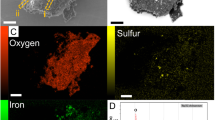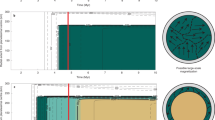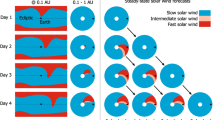Abstract
ALTHOUGH the existence of natural remanent magnetization in meteorites has been taken as evidence for a primaeval magnetic field in the original bodies—presumably of asteroidal dimensions—from which meteorites formed1, it seems surprising that an asteroidal core (∼ 100 km diameter as an upper limit) can sustain convective motions efficient enough to produce the magnetic field, ∼ 10−1 to 1 G, required by the NRM measurements2. Moreover, recent data suggest that iron meteorites are not necessarily fragments of a much larger core, as had been supposed, but formed as small bodies embedded in a silicate matrix3. As there is no other obvious internal mechanism for generating NRM, could an external mechanism be responsible? During the early history of the solar system, the magnetic field of the Sun may have been much more intense than it is at present, possibly ∼ 100 G (ref. 4), and the rotation of the Sun may have been much more rapid. A recent estimate for solar spin damping by the solar wind gives an e-folding time ∼2.2×109 yr (ref, 5). There are two mechanisms by which NRM could have been created in meteorites under these conditions.
This is a preview of subscription content, access via your institution
Access options
Subscribe to this journal
Receive 51 print issues and online access
$199.00 per year
only $3.90 per issue
Buy this article
- Purchase on SpringerLink
- Instant access to full article PDF
Prices may be subject to local taxes which are calculated during checkout
Similar content being viewed by others
References
Anders, E., Space Sci. Rev., 3, 583 (1964).
Stacey, F. D., Lovering, J. F., and Parry, L. G., J. Geophys. Res., 66, 1523 (1961).
Urey, H. C., Mon. Not. Roy. Astron. Soc., 131, 199 (1966).
Hoyle, F., and Wickramasinghe, N. C., Nature, 217, 415 (1968).
van den Heuvel, E. P. J., and Conti, P. S., Science, 171, 895 (1971).
Sonett, C. P., Colburn, D. S., Schwartz, K., and Keil, K., Astrophys. Space Sci., 7, 446 (1970).
Butler, R. F., and Cox, A. V., Science, 172, 939 (1971).
Jain, A. V., and Lipschutz, M., in Meteorite Research (edit. by Millman, P. M.) (Reidel, Dordrecht, 1968).
Lipschutz, M., in Shock Metamorphism of Natural Materials (edit. by French, B. M., and Short, N. M.) (Mono Book Corp., Baltimore, 1968).
Graham, R. A., Anderson, D. H., and Holland, J. R., J. Appl. Phys., 38, 223 (1967).
Agrell, S. O., Long, J. V. P., and Gilvie, R. E., Nature, 198, 749 (1963).
Pochtarev, V. I., and Gushova, Ye. G., Geomag, i. Aeronom., 2, 749 (1962).
Dence, M., in Shock Metamorphism of Natural Materials (edit. by French, B. M., and Short, N. M.) (Mono Book Corp., Baltimore, 1968).
Author information
Authors and Affiliations
Rights and permissions
About this article
Cite this article
MEADOWS, A. Remanent Magnetization in Meteorites. Nature 237, 274 (1972). https://doi.org/10.1038/237274a0
Received:
Issue date:
DOI: https://doi.org/10.1038/237274a0
This article is cited by
-
The Explored Asteroids: Science and Exploration in the Space Age
Space Science Reviews (2015)
-
Magnetism of the Moon - a lunar core dynamo or impact magnetization?
Surveys in Geophysics (1993)
-
Primary and secondary magnetizations in lunar rocks - Implications for the ancient magnetic field of the Moon
Earth, Moon, and Planets (1985)
-
Electrophoretic mobilities and levels of T and B lymphocytes in human pregnancy
Archives of Gynecology (1984)
-
The magnetic effects of brecciation and shock in meteorites: II. The ureilites and evidence for strong nebular magnetic fields
The Moon and the Planets (1979)



